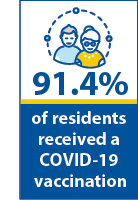A 96-bed, in-patient rehabilitation and nursing facility was referred by the Centers for Medicare & Medicaid Services (CMS) to Quality Insights, a CMS Quality Innovation Network-Quality Improvement Organization (QIN-QIO), for assistance with increasing its resident COVID-19 vaccination rate. The QIN-QIO conducted a root-cause analysis (RCA) and helped the facility identify underlying barriers and create a solution-oriented plan to address the obstacles uncovered by the RCA. This led to 91.4 percent of residents receiving a COVID-19 vaccination, a 58.4 percent increase from when the f acility was first referred to the QIN-QIO and the last report to the National Healthcare Safety Network (NHSN) database in January 2023.
acility was first referred to the QIN-QIO and the last report to the National Healthcare Safety Network (NHSN) database in January 2023.
Obtaining Consents from Transient Patient Population is the First Step
Due to 50 percent of the facility’s patients being short-term rehabilitation residents, achieving and maintaining a high resident COVID-19 vaccination rate is very challenging. Many residents only spend one to two weeks at the facility as patients. The result is that facility staff are continually evaluating, educating, and attempting to gain consent from residents to ensure a high COVID-19 vaccination rate.
The facility administrator shared with Quality Insights that the facility staff was strong in educating and consenting patients. The team’s process is to ask new admits if they are up to date on their COVID-19 vaccine and then educate and ask for consent to administer the vaccine for those who are not. A member of the facility’s social services staff receives a list of residents who did not consent upon admission. They follow up with these residents to provide further education, resulting in more consents.
Despite being able to obtain consents from many new admitted patients, some were still not vaccinated by the time of discharge. Therefore, there was another underlying root cause for the facility’s low vaccination rates.
Using Root-Cause Analysis to Shed Light on an Obvious Solution
Asking the right questions is critical in discovering opportunities to make improvements. Quality Insights collaborated with the facility through email and phone communications using a variety of descriptive questions to understand more about their admission consent and vaccination process. Through this discovery, it was learned that 50 percent of their residents are only in rehabilitation treatment for a short period of time. The main issue that surfaced was that many of the rehabilitation residents are often discharged by the time an outside pharmacy vaccine clinic could be coordinated and conducted. Not having easy, on-site access to the vaccine was contributing to the facility’s low resident COVID-19 vaccination rate.
During the RCA meeting with the facility administrator, Quality Insights recommended contacting the pharmacy to request utilizing single-dose COVID vaccine vials onsite. Once the facility had a supply of vials on hand, the nursing staff was able to administer the vaccine onsite soon after gaining consent. The success is the facility increased its resident vaccination rate by 58.4 percent, resulting in 91.4 percent of residents being up to date on their vaccines, overcoming the challenge posed by the facility’s high population turnover.
Helpful Resources for Facilities Facing Challenges Raising Resident Vaccination Rates
Quality Insights provides the following resources to facilities facing challenges raising resident vaccination rates:
- Adult Immunization Toolkit for Clinicians
This toolkit provides clinicians with resources to help improve adult immunization rates. - COVID-19 Vaccine Communication and Confidence Checklist
Use this checklist to promote COVID-19 vaccine confidence among your healthcare personnel. - The COVID-19 Vaccine Confidence Conversation Starter
Engage health facility/clinic staff at different levels to identify practical ways to promote vaccine confidence and support high vaccine uptake. - CDC Meaningful Conversations with Patients
An introduction to motivational interviewing for healthcare professionals. - Invest in Trust: A Guide for Building COVID-19 Vaccine Trust Among Certified Nursing Assistants (CNAs)
Designed to help nursing home leaders build COVID-19 vaccine confidence among CNAs and overcome barriers to vaccination by applying insights from social, behavioral, and cognitive science.
Quality Insights also offers a weekly e-bulletin, the Last-Minute Lowdown, that provides the latest news on immunizations, long-term care, and skilled nursing facilities — plus resources from CDC, CMS, state health agencies, and Quality Insights. These ongoing support strategies continue to encourage the facility’s progress.
 Keys to Success
Keys to Success
Quality Insights’ success helping the facility achieve a 91.4 percent resident COVID-19 vaccination rate can be replicated by taking the following steps:
- Ask the right questions. Through an RCA ask in-depth, clarifying questions. Examples are: Have you had a recent vaccine clinic? How many residents and staff participated? What are your barriers to increasing your vaccination rates?
- Identify a simple solution. Remember to consider easy and obvious answers to overcome barriers. Doing something slightly different can garner big results.
- Quick to action. Utilizing the appropriate resources to implement turn-key improvements.
This material was prepared by The Bizzell Group (Bizzell), the Data Validation and Administrative (DVA) contractor, under contract with the Centers for Medicare & Medicaid Services (CMS), an agency of the U.S. Department of Health and Human Services (HHS). Views expressed in this material do not necessarily reflect the official views or policy of CMS or HHS, and any reference to a specific product or entity herein does not constitute endorsement of that product or entity by CMS or HHS. 12SOW/Bizzell/DVA-1242-11/30/2023.

